Hydroponics is a system of ideal growing method for producing pure and medicinal plants. Hydroponic plants grow faster but have more flavour and aroma than soil-grown plants. The best hydroponic nutrients contain minerals and essential elements, such as nitrogen, phosphorus, and potassium, critical in plant life. These nutrients are necessary for your plants to grow and flourish. Let’s check out more information about the hydroponic nutrient solution.

Hydroponics is a method of gardening in which flowers, herbs, and vegetables are grown using water. Before a plant can produce fruit, it must first produce flowers. The transfer of hydroponics to the flowering stage requires a change in plant nutrition. Growing vegetables in a traditional garden or with hydroponics, proper nutrients can help increase productivity, sweet vegetables, and strong stems. Nutritional formulas are constantly improving so that we can achieve better results.
Hydroponic Nutrient Chart
Importance of Hydroponic Nutrient Solution for Plants
Hydroponics is a profitable, sustainable agricultural method and environmentally friendly technology for growing soilless plants. It is the fastest-growing agricultural sector, rapidly gaining momentum and popularity, and may dominate food production in the future. Nutrition solutions and management are the foundation of a successful hydroponic system. They are the most important determinants of crop production and quality, depending on how plant nutrients are absorbed from the solution.
The composition of the solution reflects the ratio of emission of individual elements of the crop. All the nutrients in the solution are supplied directly to the plants in a balanced proportion. With some exceptions, the optimum pH range for hydroponically grown crops is usually between 5.5 and 6. Many fruits and vegetables like Melons, Apples, Beans, Squash, and Tomatoes prefer this range. On the other hand, blueberries require a low, high acid pH between 4.0 and 5.0.
As a Home Gardener, You Can Grow Small Flowers, Herbs, Or Vegetables.
Vegetables grown in hydroponics require high nutrients during the plant and fruit stages. Therefore, your hydroponic garden’s selected growing medium (substrate) can affect how well your plants grow. Initially, you can experiment with a few options before investing in a particular medium. Over time, you’ll likely find one or two media options.
Unlike the complex chemical soup hydroponic gardening suppliers offered in the past, most companies now recognize the value of growing plants using naturally occurring nutrients. The suitable medium will support the root and provide your plants with a constant ratio of oxygen and water for optimal growth. It is easy to try many mediums on a small scale. High-quality nutrition solutions are essential for the success of any garden.
In case you missed it: Hydroponic Farming Cost and Profit in India: Cultivation and Production Management
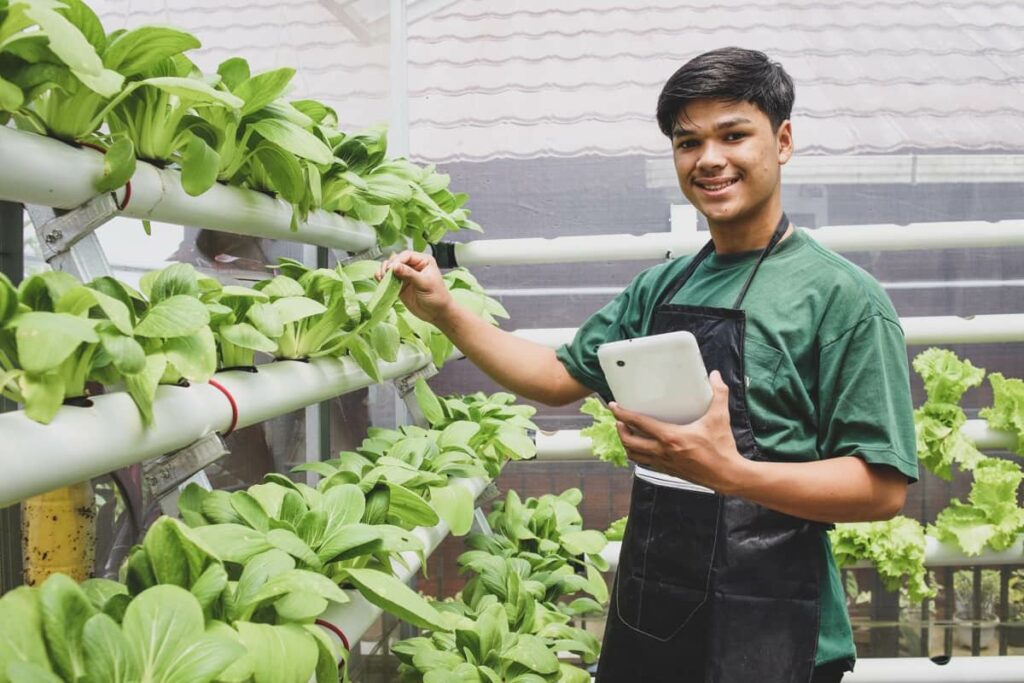
In a traditional garden, the fertilizer or nutrient solution depends on the soil so that many micronutrients and minerals can be detected for the healthy growth of plants. Nutritional solutions formulated for hydroponics should provide the right balance of nutrients in which easily absorbed compounds should be traced to minerals. The deficiency of trace minerals or imbalance of micronutrients in your solution will hinder the optimal growth of plants.
EC and pH Levels for Hydroponic Plants
Hydroponic fertilizer often comes in liquid or powder form, which you can dilute and add to your growing system as needed. Providing optimal growing conditions is recommended to get the best results from their hydroponic plants. The simple chart below shows the recommended EC (electrical conductivity), pH (potential hydrogen), and the best hydroponic or organic soil growing media for each type of vegetable.
The compound contains organic ingredients such as mud castings, blood feeds, fish meal, kelp, or guano, used during feeding and rearing. In addition to fertilizers, hydroponic gardeners should add trace elements commonly found in healthy soil, as growing media will become inactive. Look especially for products that advertise minerals on the label. You can substitute sulfuric acid or dolomite lime if you grow plants with a mild pH range.
Nutrient Mix for a Hydroponic System
Nutrients are essential parts of any hydroponic system. It must be dissolved in water to add fertilizer to a hydroponic system. If not, the plant cannot access it. The farmer controls the fertilizer process with hydroponics depending on the type and concentration. They also can monitor immediately and maintain relevant consistency, providing a nutrition meter is available.
Nutrient composition is essential, and more than twenty elements are needed for a plant to grow. Carbon, hydrogen, and oxygen are absorbed by air and water. The remaining elements, mineral nutrients, are dissolved in the nutrient solution and must be in the proper proportions. Any good hydroponic nutrition should contain all of these elements.
Nitrogen (N), Potassium (K), Phosphorus (P), Calcium (Ca), Magnesium (Mg), Sulfur (S), Iron (Fe), Manganese (Mn), Copper (Cu), Zinc (Zn), Molybdenum (Mo), Boron (B), Chlorine (Cl). The most common nutrients for hydroponics are fertilizers containing nitrogen, phosphorus, and potassium in liquid and dry forms. For hydroponics, you’ll want to get these three nutrients to fertilize your system regularly:
- N-P-K Mix
- Calcium Nitrate
- Epsom Salt (Magnesium Sulfate)
Your crops absorb oxygen, hydrogen, and carbon from the water and air around them. The secondary nutrients for plant growth are calcium, magnesium, and sulfur. The other essential nutrients are nitrogen, phosphorus, and potassium. They will be provided in the NPK fertilizer you use.
In case you missed it: 20 Key Rules for Setting Up a Budget Hydroponic Garden at Home
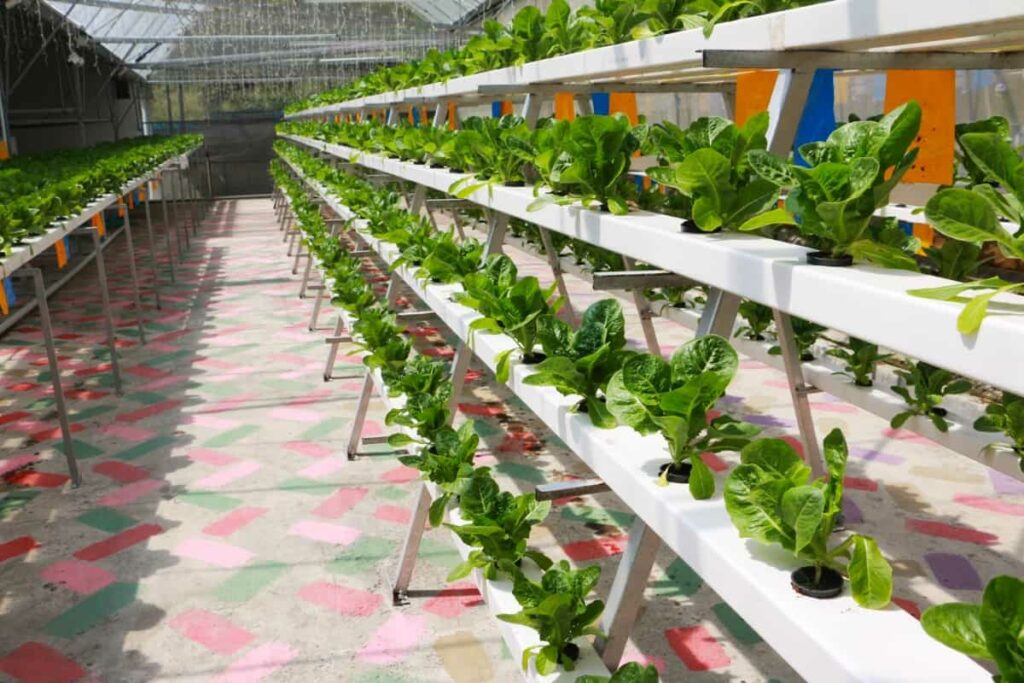
How Do You Identify the Right Mix of Nutrients?
You need to understand these compounds when purchasing organic nutrients properly. For example, all hydroponic plants require a mixture of micro and macronutrients. Macronutrients form the basis of plant nutrition and must be added throughout the year. Micronutrients, on the other hand, are called trace elements.
These are sometimes required in minimal quantities. Nutrients include oxygen, nitrogen, magnesium, phosphorus, potassium, hydrogen, sulfur, and calcium. In addition, iron, cobalt, molybdenum, nickel, manganese, chlorine, silicon, sodium, and zinc are essential micronutrients.
Nutrients Used for Growing Plants in Hydroponics
Organic Nutrients
These are essential in hydroponics. Plants cannot absorb heavy particles and can block the hydroponic system in which plants are grown. But they must be free of substances that can accumulate. Organic Nutrients Contain ingredients used in organic gardening.
Plant Booster
These boosters are relatively new to the market and help plants absorb nutrients that enter the water. It improves the growth of plants. Some hydroponic nutrients are available in the market, further intensifying plant flowering. These modern recipes should only be used if you have a large garden. Technically, high-grade organic hydroponic plant nutrients should only be used under expert guidance.
Maximum Yield Defines Hydroponic Nutrients
Hydroponic systems require specific hydroponic nutrients due to growing conditions without soil. Hydroponically grown plants like hydro corn, puffed rock, expanded clay pellets, rock wool, coco coir, or perlite sit in the middle. No medium is used around the plant roots (DWC) in deep water culture. Without soil, the plant has no way of absorbing nutrients.
Instead, it should rely on hydroponic nutrients to meet its nutritional and mineral needs. Hydroponically grown plants require daily hydroponic nutrient solutions to grow. Several times a day, hydroponic nutrients are packed in trays around the plant’s roots and then stored in a reservoir for later use. Once the liquid gets out of the roots, the plant can absorb oxygen.
It is because plants need different amounts of different nutrients during their growth. Hydroponic nutrients are sold in multi-part bottles, one for growing and one for opening. In this way, a farmer can meet the nutritional needs of his crop to get the maximum yield.
In case you missed it: How to Grow Hydroponic Vegetables Indoors: Key Rules, Methods, and Tips
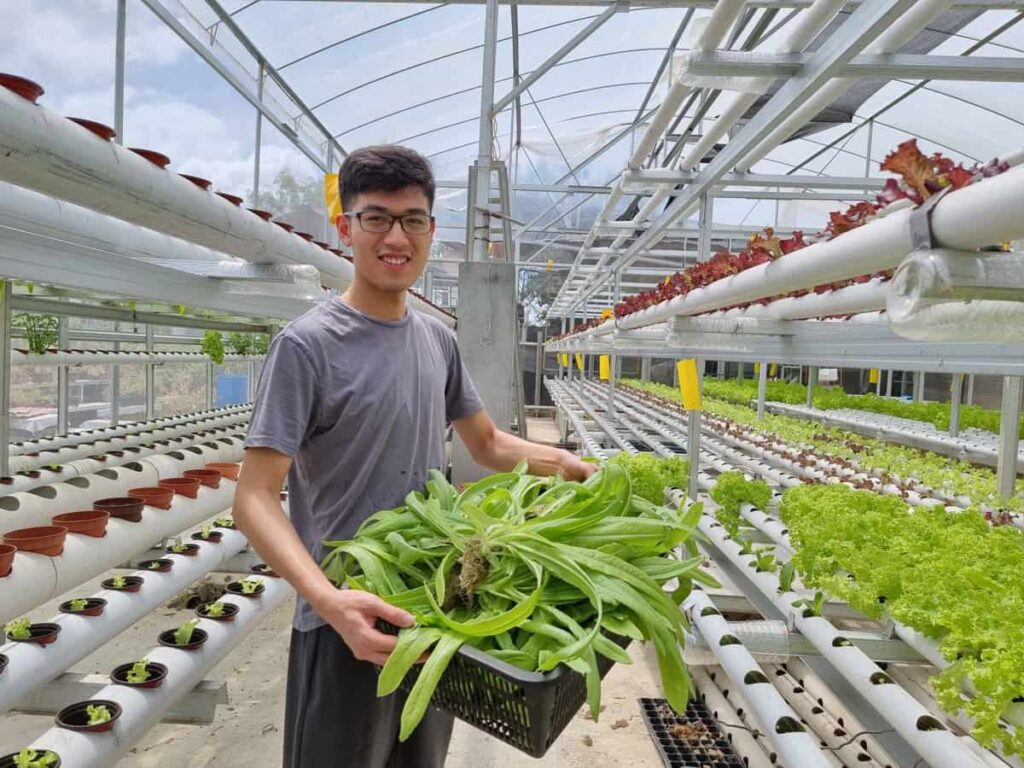
Hydroponic Nutrients for Growing Flowers
Flowers grown in hydroponics have some advantages over the traditional soil culture. Growing flowers in a hydroponic system give you complete control over the supply of nutrients and the pH balance, allowing you to adapt to the environment. In addition, with the physical barrier of the soil, plants can expend more nutrient energy on their roots. Grow your flowers using hydroponics if you like instant results
Flowers Grow Well In Hydroponics
Peace lilies, Hoya, Snapdragons, Dahlias, Rex Begonias, Carnations, Orchids, Petunia, Zinnia, Orchids, Amaryllis, Iris, Daffodils, Freesia, Chrysanthemums, and Gerbera.
Hydroponic Nutrient Chart for Flowers
| Flowers | Optimum pH | EC |
| African Violets | 6.0-7.0 | 1.2-1.5 |
| Aster | 6.0-6.5 | 1.8-2.4 |
| Roses | 5.5-6.0 | 1.5-2.5 |
| Gerbera | 5.0-6.5 | 2.0-2.5 |
| Impatiens | 5.5-6.5 | 1.8-2.0 |
| Ficus | 5.5-6.0 | 1.6-2.4 |
| Dahlia | 6.0-7.0 | 1.5-2.0 |
| Begonia | 6.5 | 1.4-2.4 |
| Carnation | 6.0 | 2.0-3.5 |
| Chrysanthemum | 6.0-6.2 | 1.8-2.5 |
Hydroponic Nutrients for Growing Herbs
Provide basic nutrients. Fortunately, most of them are suitable for herbs at all stages of development. If you want to increase the yield of your herbs, make sure you use them wisely. Since most herbs are vegetative, a well-grown formula with relatively high nitrogen to phosphorus ratio, hydroponic nutrition is a great choice for growing most herbs. Low to medium electrical conductivity (EC), a measure of nutritional strength is generally preferred.
An EC range of approximately 1.2-1.8 and a slightly acidic p of about 5.8 to 6.4 will be ideal for most pure herbs. For example, Parsley and Watercress grow well with EC near light Lettuce (1.0 EC) in light nutrient formulas, while English Spinach grows better at much higher ECs (2.5-3.5 EC). Hydroponic growing systems are an effective option for indoor herb gardens, especially when there is a lack of space for outdoor planting.
This type of soil-less gardening allows you to control the growth conditions of your plants from time to time, resulting in larger, healthier specimens that reduce the risk of pests or diseases. Since hydroponically grown herbs have no contact with natural soil, it is important to use the right nutritional solutions and growth media. Most indoor herbs work best with plenty of blue spectrum and full-spectrum light. There are two types of nutrients used in a hydroponic system: base nutrients and additives.
When choosing the essential nutrients for your herbs, first consider the N-P-K ratio (nitrogen (N), phosphorus (P), and potassium (K)). If the ratio of N-P-K is 5-5-5, it means that the solution is composed of 5% nitrogen, 5% phosphorus, and 5% potassium. Most basic nutrients have a balanced N-P-K ratio. If your plants need strong leaves and stalks and more protein, choose a solution with an N-P-K ratio of 20-6-6. Most herbs do well in the pH range of 5.5-6.5 and EC range of 1.0-1.6.
In case you missed it: How to Maintain the pH Levels of Hydroponic Systems: Increase, Decrease, and Stabilize
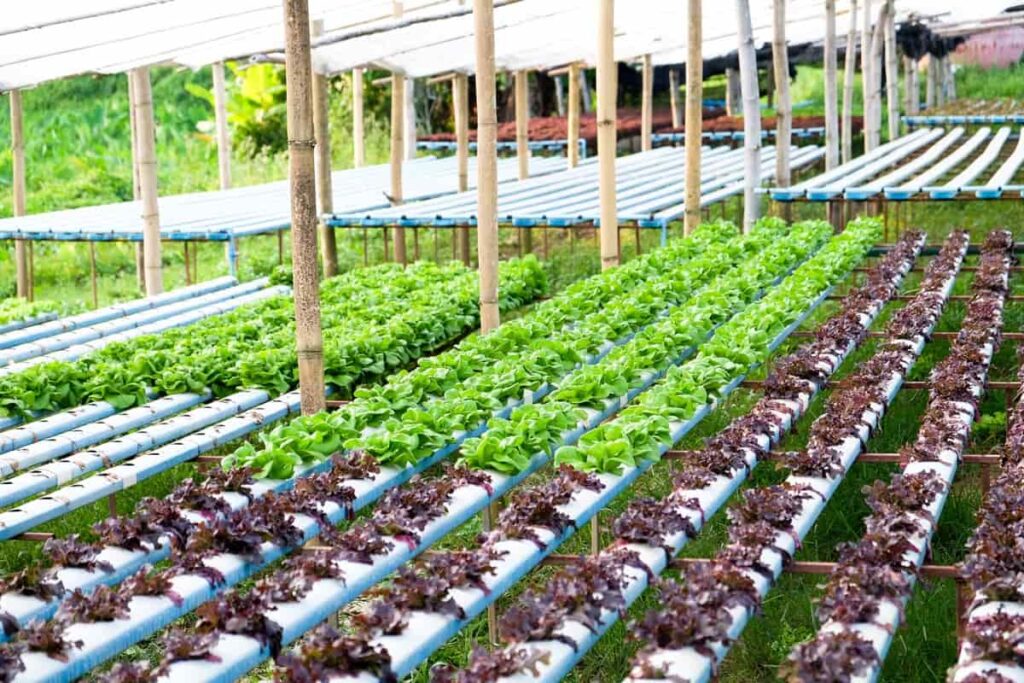
Hydroponic Nutrient Chart for Herbs
| Herb | Optimum pH | EC |
| Anise | 5.8-6.4 | 0.9-1.4 |
| Basil | 5.5-6.0 | 1.0-1.6 |
| Thyme | 5.5-7.0 | 0.8-1.6 |
| Dill | 5.5-6.4 | 1.0-1.6 |
| Watercress | 6.5-6.8 | 0.4-1.8 |
| Tarragon | 5.5-6.5 | 1.0-1.8 |
| Mint | 5.5-6.0 | 2.0-2.4 |
| Lemon Balm | 5.5-6.5 | 1.0-1.6 |
| Sage | 5.5-6.5 | 1.0-1.6 |
| Rosemary | 5.5-6.0 | 1.0-1.6 |
| Oregano | 6.0-7.0 | 1.8-2.3 |
| Parsley | 5.5-6.0 | 0.8-1.8 |
| Lavender | 6.4-6.8 | 1.0-1.4 |
| Fennel | 6.4-6.8 | 1.0-1.4 |
| Coriander | 5.8-6.4 | 1.2-1.8 |
| Cilantro | 5.8-6.4 | 1.2-1.8 |
| Chives | 6.0-6.5 | 1.8-2.4 |
Suitable Herbs for Hydroponic Systems
The most common kitchen herbs grow well in hydroponic systems. Some of the most common include Basil, Lemon Balm, Mint, and other members of the Lamiaceae family, such as Sage and Rosemary. Tall herbs such as Lemongrass may need extra help. Plants such as Ginger, Garlic, and Turmeric, which grow from rhizomes or bulbs, are generally poor candidates for the domestic hydroponic system. You can grow herbs hydroponically using various growth media, including sterile root cubes made from peat and vermiculite or cellulose fiber.
Plants growing well in hydroponics – Cilantro, Chamomile, Lemon Balm, Marjoram, Oregano, Mint, Thyme, Basil, and Watercress. They help support the plants. Growing herbs directly into a nutrient solution hydroponically is also possible, but most require physical support. Avoid peat pots or growth cubes designed for non-hydroponic gardening as they tend to disintegrate and can block your hydroponic system.
Hydroponic Nutrients for Growing Vegetables
Most hydroponic systems use water and solutions made from various nutrients. Some hydroponics uses something called a growing medium or media. Some media resemble clay and are called growing media without soil. Other growing mediums, such as clay pellets or gravel, look nothing like clay. Sphagnum moss or coconut coir is used to retain moisture. Each growing medium has its chemical makeup and nutritional requirements.
With or without media, all methods require planning for optimal crop results. Vegetables and fruits are two sources of nutrients for growers. The two sources of nutrients are conventional (mineral) and organic (biological). This gardening method allows vegetables and plants to grow anywhere, regardless of soil type, yard size, weather, or climate. Seed selection is the primary key to the success of your gardening endeavour.
It is recommended to choose those seeds resistant to diseases carefully and produce high-quality nutrients. Your hydroponic garden must have a pH meter, EC meter, hydroponic nutrients, and cans for stock solution. Organic neem oil, hydrogen peroxide, a common biopesticide, and small bio fungicides can be used for pest and disease management. Vegetables that grow well in hydroponics are Lettuce, Cucumbers, Spinach, Beans, Peppers, Chives, and Tomatoes.
In case you missed it: How to Start Hydroponic Farming in Australia: Scope, Types, Pros, and Cons
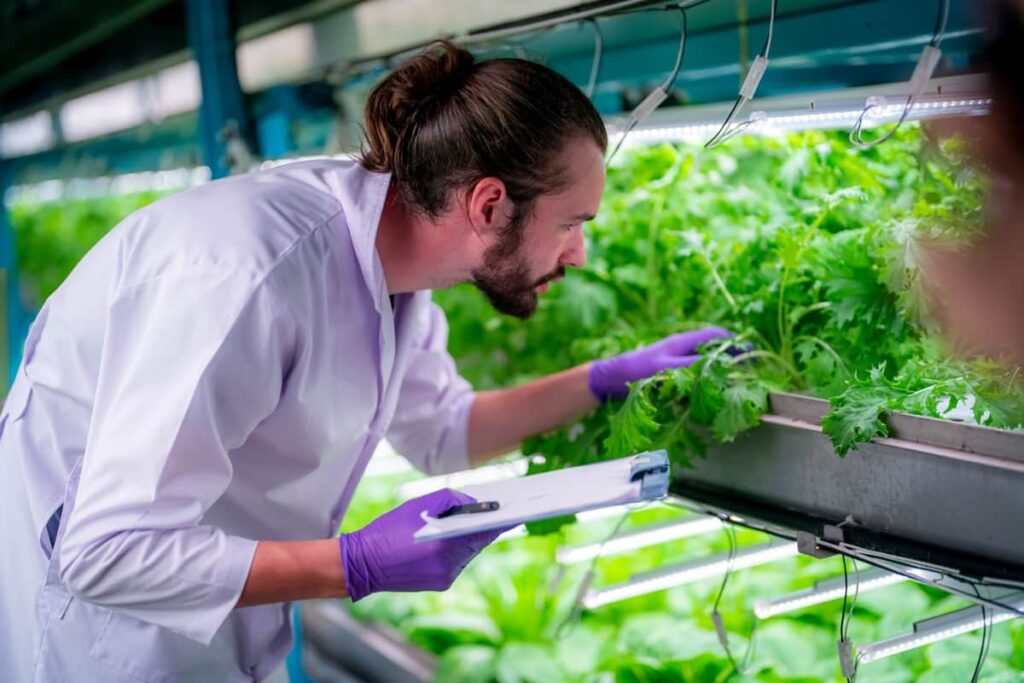
Hydroponic Nutrient Chart for Vegetables
The pH and EC values are the most important in hydroponics. Each vegetable plant has a unique pH level and EC value, and it should be in an ideal range for it to thrive. You can measure these values with either test strips or digital meters. If the solution is too acidic, the micronutrients will be absorbed in toxic amounts, while the macronutrients disappear. On the other hand, if the solution is too alkaline, the vegetable plants will not absorb the micronutrients.
| Vegetables | Optimum pH | EC |
| Artichoke | 6.5-7.5 | 0.8-1.8 |
| Zucchini | 6.0 | 1.8-2.4 |
| Turnip | 6.0-6.5 | 1.8-2.4 |
| Tomatoes | 5.5-6.5 | 1.5-2.5 |
| Spinach | 6.0-7.0 | 1.8-2.3 |
| Radish | 6.0-7.0 | 1.6-2.2 |
| Pumpkin | 5.5-7.5 | 1.8-2.4 |
| Potato | 5.0-6.0 | 2.0-2.5 |
| Pea | 6.0-7.0 | 0.8-1.8 |
| Parsnip | 6.0 | 1.4-1.8 |
| Okra | 6.5 | 2.0-2.4 |
| Onions | 6.0-6.7 | 1.2-1.8 |
| Lettuce | 5.5-6.5 | 0.8-1.2 |
| Garlic | 6.0 | 1.4-1.8 |
| Ginger | 5.8-6.0 | 2.0-2.5 |
| Kale | 5.5-6.5 | 1.25-1.5 |
| Eggplant | 5.5-6.5 | 2.5-3.5 |
| Leeks | 6.5-7.0 | 1.4-1.8 |
| Cucumber | 5.8-6.0 | 1.7-2.5 |
| Chili | 5.8-6.3 | 1.8-2.8 |
| Cauliflower | 6.0-7.0 | 0.5-2.0 |
| Carrots | 6.3 | 1.6-2.0 |
| Cabbage | 6.5-7.0 | 2.5-3.0 |
| Broccoli | 6.0-6.5 | 2.8-3.5 |
| Beetroot | 6.0-6.5 | 0.8-5.0 |
| Beans | 6.0-6.5 | 1.8-2.5 |
| Asparagus | 6.0-6.8 | 1.4-1.8 |
- Sheep Farming Business Plan for Beginners
- Aquaponic Farming at Home: A Step-By-Step Guide
- Profitable Village Farming Business Ideas in 2024
- High-Yield Aquaculture: Fast-Growing Fish for Farming
- Effective Fish Pond Construction Techniques for Beginners
- Irrigation and Water Management in Pineapple Farming
- Blossom to Harvest: Mastering Flowering and Pollination in Papaya Farming
- Pig Fattening Essentials: From Selection to Sale for Beginners
- Raising Wagyu Cattle: A Complete Guide for Premium Beef Production
- Soil Types and Their Water Holding Capacity
- Optimizing Irrigation Schedules for Coconut Groves for Enhanced Yield
- Espresso Your Garden: Coffee Grounds for Healthier Acid-Loving Plants
- The Best Soil Mix for Snake Plants: How to Mix Your Own Snake Plant Soil
- Green Thumb Success: Expert Tips for Cultivating Greenhouse Beans All Year Round
- Bloom All Year Round: The Ultimate Guide to Indoor Hyacinth Care
- Eco-Friendly Gardening: How to Make Liquid Fertilizer from Kitchen Waste
- Ultimate Guide to Grow Anise in Pots: Explore Seed Propagation to Harvesting
- Guide to Raising Chester White Pigs: Discover Breed Facts to Growth Management
- Mastering the Elegance: The Ultimate Guide to Weeping Cherry Tree Care, Planting, and Maintenance
- Ultimate Guide to Planting Garlic in Grow Bags: Growing Strategies for Beginners
- How to Fix Spider Plant Leaf-Related Problems: Natural and Organic Remedies
- 10 Reasons Why Your Tulsi Plant is Shedding Leaves: Home Remedies and Solutions
- Optimizing Growth and Yield: The Advantages of Palm Bunch Ash Fertilizer
- Utilizing Neem Oil Extract as a Natural Pesticide for Hydrangea
- From Soil to Harvest: Various Ways in Which Farmers Can Use AI Tools
- Steps to Encourage and Induce Citrus Flowers: A Comprehensive Guide
- How to Fix Snake Plant Leaf-Related Issues: Natural and Organic Remedies
- Transform Your Garden into a Fragrant Oasis with Raat Ki Rani (Night Blooming Jasmine)
- Discover the Ideal Chicken Breeds for Philippine Farms
- How to Create a Poultry Egg Farm Business Plan for Profits
- Grow Lemon Cucumbers Like a Pro: Insider Techniques for Bountiful Yields
- Ultimate Guide to Caring for Your Pink Princess Philodendron: Tips for Thriving Variegation
- Areca Nut Profit Per Acre: Calculating Yield and Cost of Cultivation
- How Kaveri Chicken is Becoming a More Profitable Breed in Indian Backyards
- Transform Your Barn: 9 Steps to Convert a Horse Stall into a Chicken Coop
- Exploring Suffolk Sheep Disadvantages with Limitations and Challenges
